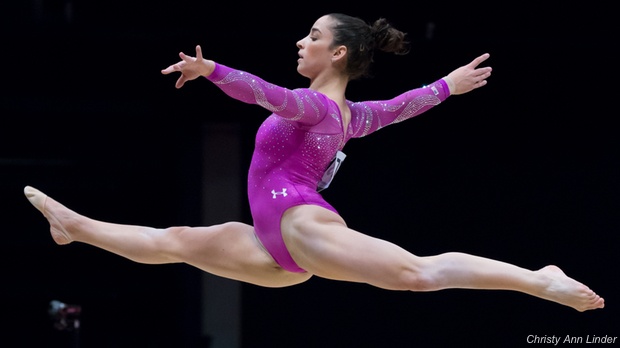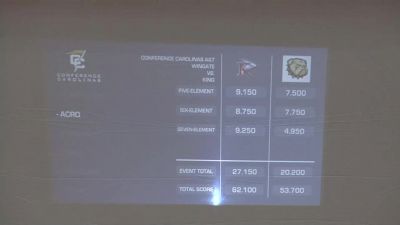World Championships Glasgow 2015Oct 27, 2015 by Justine Kelly
The Two-Per-Country Rule & Its Impact in Glasgow
The Two-Per-Country Rule & Its Impact in Glasgow
At the 1970 World Artistic Gymnastic Championships, three gymnasts from the Soviet Union captured the gold, silver and bronze medals on floor exercise. Fiv


At the 1970 World Artistic Gymnastic Championships, three gymnasts from the Soviet Union captured the gold, silver and bronze medals on floor exercise. Five Soviet gymnasts also competed in the all-around that year, with two of them winning gold and bronze. On the men’s side, three Japanese gymnasts won all three medals in the all-around, high bar and floor exercise. A few years later, at the 1972 Olympics, three Japanese men captured all three all-around medals once again, in addition to going 1-2-3 on parallel bars and high bar.
Times have certainly changed since then. Starting with the 1976 Olympics in Montreal, the FIG implemented new rules, allowing only three gymnasts per country to compete in all-around finals, and two gymnasts per country for event finals. In 2003, they changed the rules again, limiting the number of gymnasts competing in the all-around final to two per country.
The rule has been controversial ever since, with arguments surfacing on both sides. On one hand, the rule allows for diversity in World and Olympic competitions, preventing one country from dominating the competition and allowing more countries to compete in finals. On the other hand, the rule also prevents some of the top gymnasts in the world from competing, especially if they come from a top gymnastics country.
The rule famously impacted Jordyn Wieber at the 2012 Olympics when she placed 4th behind teammates Gabby Douglas and Aly Raisman in the all-around qualifications, finishing just 0.233 behind Douglas. Raisman and Douglas advanced to finals while Wieber had to watch from the stands, despite her performing far better than many of the other gymnasts who advanced from other countries. On beam, Kyla Ross placed just 0.25 behind Raisman in qualification, but she finished 3rd behind Raisman and Douglas, causing her to sit out finals as well.
In the all-around competition, the top 24 gymnasts advance to finals. This time, at World Championships in Glasgow, Raisman is one of the gymnasts negatively impacted by the rule. She placed 5th in all-around qualifications, but behind teammates Simone Biles and Douglas. Ellie Downie (GBR) also won’t be able to compete in finals. She placed 20th overall, behind teammates Ruby Harrold and Amy Tinkler.
It is important to remember, however, that removing one gymnast from competition allows a different gymnast the opportunity to compete. Looking at it from the other side, the rule will allow Germany’s Elisabeth Seitz to compete in the all-around final, despite placing 26th. She will be the 2nd German gymnast in the competition. Canada’s Isabela Onyshko placed 27th and will also be able to compete, resulting in Canada’s second gymnast in competition.
On bars, Biles misses out on finals after placing behind Madison Kocian and Douglas in 8th place in qualification. Maria Paseka (RUS) also misses out, having placed 6th behind teammates Daria Spiridonova and Viktoria Komova. In this case, the rule allows Harrold (GBR) to compete, as well as China’s Shang Chunsong, arguably two of the most impressive bar workers in the world.
On beam, it was Russia who was impacted, with Maria Kharenkova placing 7th behind teammates Komova and Seda Tutkhalian. In this situation, the rule is allowing The Netherlands’ Eythora Thorsdottir to compete in finals (at her first Worlds competition). Lastly, the rule comes into effect on floor, once again removing Raisman from finals after she placed 7th behind teammates Biles and Maggie Nichols. The result is that Ellie Downie (GBR), who placed 10th, will be competing in finals.
The rule impacted the men’s all-around competition as well, with five gymnasts who placed in the top 24 having to sit out of finals as a result of the rule. Most dramatically, Great Britain had three gymnasts place in the top 10. Max Whitlock and Nile Wilson actually tied with a total all-around score of 88.365, behind their teammate Daniel Purvis. Due to tie-breaker rules, only Whitlock is able to advance to finals. Other gymnasts impacted were Yusuke Tanaka (JPN), Lin Chaopan (CHN), Nikita Nagornyy (RUS), and Nikita Ignatyev (RUS). As a result, two countries are able to send a 2nd gymnast to all-around finals - Belarus (Andrey Likhovitskiy) and France (Jim Zona). Three countries are able to send their only gymnast for all-around finals - Spain (Ruben Lopez), Germany (Fabian Hambuechen) and Romania (Cristian Ioan Bataga).
It’s easy to see why the two-per-country rule is so controversial. On the one hand, it hurts some of the top gymnasts in the world who come from very successful gymnastic countries. The United States women’s team, for instance, is so loaded with talent that it’s inevitable one or more of them will have to sit out finals, despite placing close to the top. But the goal of the rule is not to punish, rather it is to allow for diversity on the world stage, and, by extension, to foster the growth of the sport in other countries. There will always be winners and losers when this rule comes into effect. Beyond that, the hope is that it also allows for high quality competition at a truly global level.
Related:
2015 World Championships Central
Women's Individual Finals Qualifiers
Related Content
 Replay: Lander vs Mars Hill | Mar 28 @ 6 PM
Replay: Lander vs Mars Hill | Mar 28 @ 6 PMMar 29, 2024
 Replay: Coker vs Wingate | Mar 21 @ 6 PM
Replay: Coker vs Wingate | Mar 21 @ 6 PMMar 22, 2024
 Replay: Wingate Tri-Meet - Acrobatics & Tumbling | Mar 15 @ 5 PM
Replay: Wingate Tri-Meet - Acrobatics & Tumbling | Mar 15 @ 5 PMMar 15, 2024
 Replay: Mars Hill Tri-Meet | Feb 16 @ 6 PM
Replay: Mars Hill Tri-Meet | Feb 16 @ 6 PMFeb 17, 2024
 Replay: King (TN) vs Wingate - 2024 2024 King (TN) vs Wingate - Acrobatics & Tumbling | Feb 10 @ 4 PM
Replay: King (TN) vs Wingate - 2024 2024 King (TN) vs Wingate - Acrobatics & Tumbling | Feb 10 @ 4 PMFeb 10, 2024
 Replay: Belmont Abbey vs Mars Hill | Feb 10 @ 3 PM
Replay: Belmont Abbey vs Mars Hill | Feb 10 @ 3 PMFeb 10, 2024
 How to Watch: 2024 King (TN) vs Wingate - Acrobatics & Tumbling | Gymnastics
How to Watch: 2024 King (TN) vs Wingate - Acrobatics & Tumbling | GymnasticsFeb 10, 2024
 How to Watch: 2024 Wingate Tri-Meet | Gymnastics
How to Watch: 2024 Wingate Tri-Meet | GymnasticsFeb 8, 2024
 How to Watch: 2024 Wingate Tri-Meet | Gymnastics
How to Watch: 2024 Wingate Tri-Meet | GymnasticsFeb 8, 2024